A Reference Guide To Finding Crown Land For Quick Canoe Day Trips
Everyone loves a good weekend camping trip, perhaps even squeaking in an extra day for a long weekend. That extra day can make a trip farther North worth it but unfortunately that cannot always happen. Life most often gives you only a morning before daily responsibilities need to be dealt with. With only the morning to enjoy the great outdoors we typically might go to conservation area, or perhaps the local park for a walk in the woods. The good news is that there is an even better option. An option that can give you the enjoyment of being in the backcountry with that feeling of exploration, and if you do have a free night, you might even be able to camp for FREE.
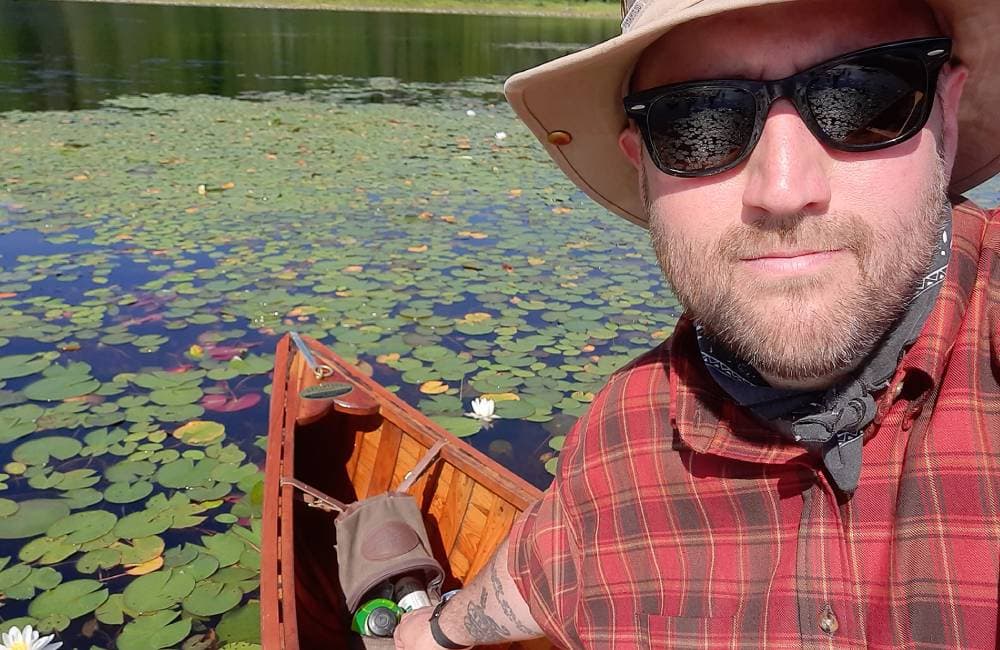
Most of us have heard of Crown Land. Land owned by the Crown for all to enjoy. A quick definition would be:
"Land, lakes and rivers that are managed by the Ontario government through the Ministry of Natural Resources and Forestry."
This write-up can act as a guide or reference for someone who wants to enjoy what I refer to as a "fast and light" canoe day trip. I will show you the resources I use to find small, easily accessible lakes and rivers. Lakes that might have campsites already on them for day use and possible overnight. Unfortunately, you will not know of these sites until you get to the lake and explore, but that is part of the adventure. I will go over what I do and use, as well as some ideas to make this kind of tripping possible through preplanning your gear and always having it at the ready. Less time packing and trying to find you gear means more time on the water or in the bush.
Crown Land Resources
To find these hidden gems on Crown Land my first step is to look at resources like the Unlostify maps or Jeff's Maps (Algonquin area). These maps show Crown land in a lighter green colour (please see legend in case they do updates or change the colour). By looking at a map this way I feel I can seem more lakes, more quickly. I can see if there are major roads nearby or even just how to get there. It also allows me to see if the lakes are in the chain, or other potential access points or major landmarks.
To make sure the Crown land you're interested in on the maps is in fact still Crown Land you can head over to the Crown Land Atlas to confirm. This map shows all Crown Land up to date. This is my least favourite resource due to its slow navigation and lack luster graphics; however, it is 100% helpful in confirming the location is good to go.
My next reference, once I pick a lake, is to check Google Maps. I have found that Google will show a bit more of the roads than the reference above. Google might even have a "street view" at the beginning of the road you are taking to give you a better idea of what you might be up against. A lot of these roads are logging roads and an AWD car is one of the better options to get down them. Google also has satellite photos which might help locate a trail leading to the lake or a portage from one lake to the other.
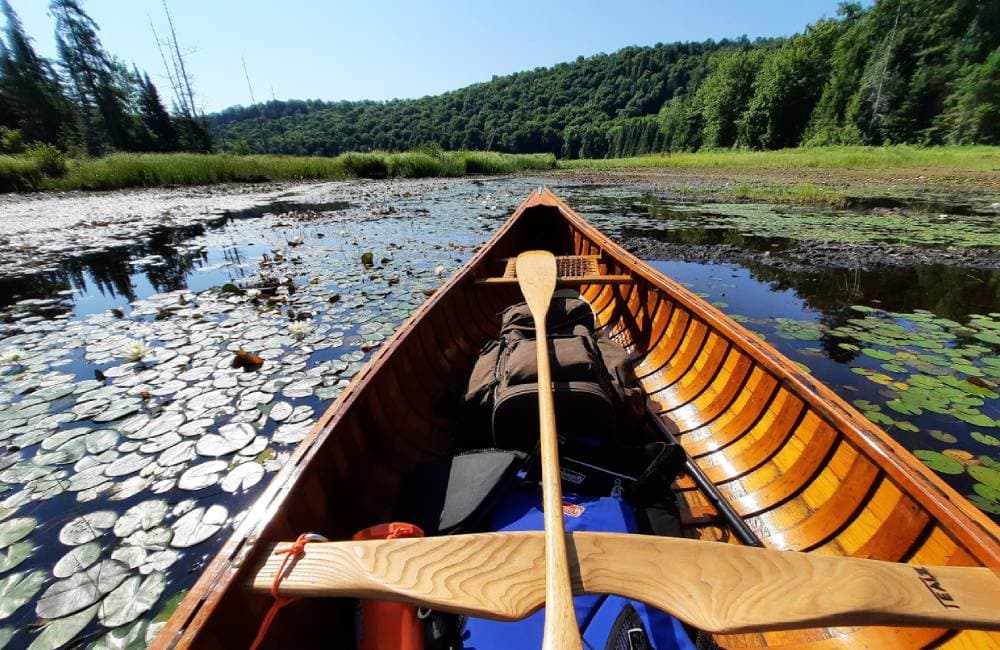
The last and potentially over-looked resource by most people is Fishing ON-Line. This is an angler's paradise for planning fishing trips, checking rules, and even identifying fish and stocked lakes. Fishing ON-line is Ontario based, and its map resource is like none other. While Google and Fishing ON-Lines both offer arial photography, Fishing ON-Lines arial photography is much clearer and can be zoomed in with greater detail. This allows you to really hone in on the lake your looking at, to see the logging road beyond what Google maps shows. You can see parking areas, ATV trails, portages, white water, or dams, and even potentially campsites. The pictures on this website are amazing
Once I find an area, I skim the Fishing ON-line to see if I can find points of interest or relics, and old cabins from years gone by. You could easily spend hours planning and exploring through their imagery trying to find the perfect location.
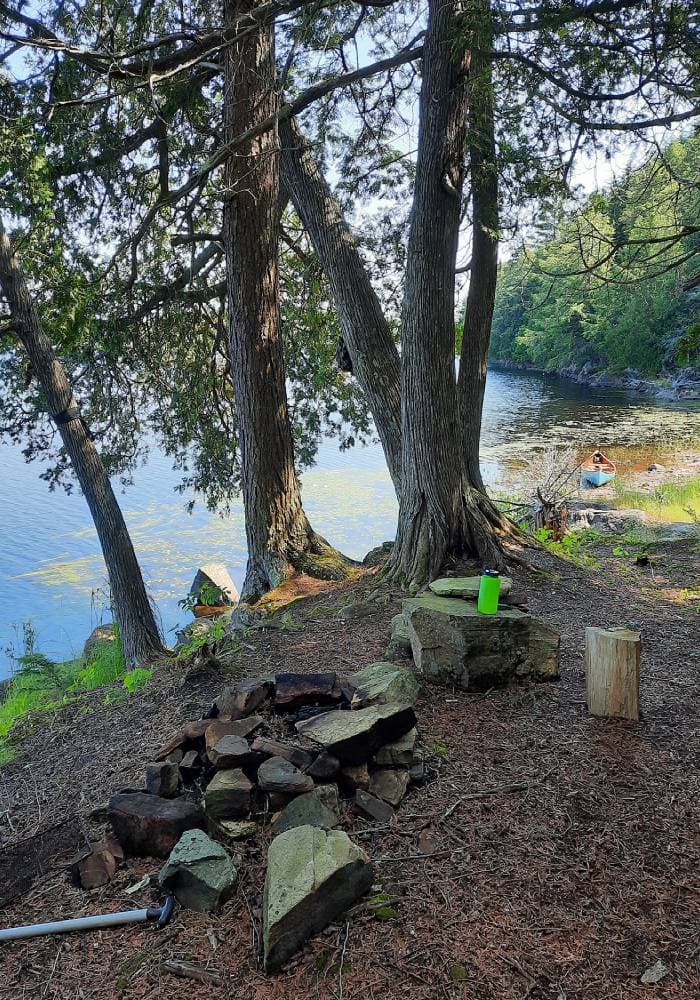
The great thing about this Crown Land is a lot of it is rough, which can make the trip well worth it. You might have to bushwhack through an unused portage to get to a lake, however once you get to the other side, you might have the whole place to yourself. I have been lucky enough to come across some old cast iron stove remains, or a cedar canoe that has 90% returned to Mother Earth. The history you can find completely out of the blue in some of these lakes in incredible.
Packing Fast and Light
The next aspect of these adventures is packing fast and light. Ideally you would want to have as much ready for these adventures as possible. Endlessly digging through you gear bins, or multiple backpacks trying to piece your equipment together can be frustrating. The good news is there is some handy tools and gear that can make this much easier and get you out on the water faster and with less headaches.
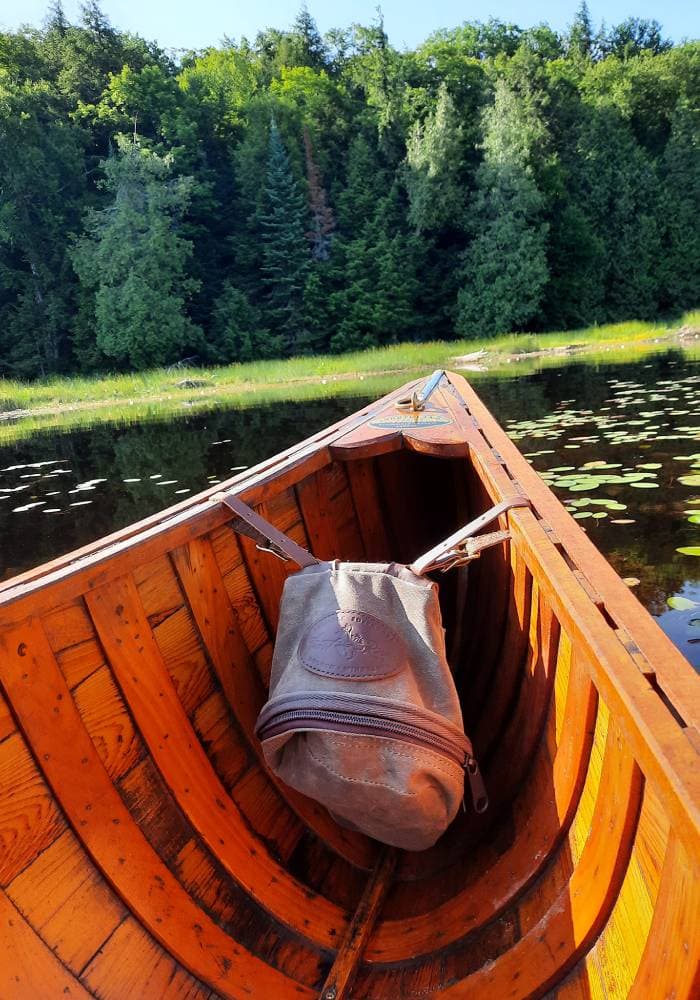
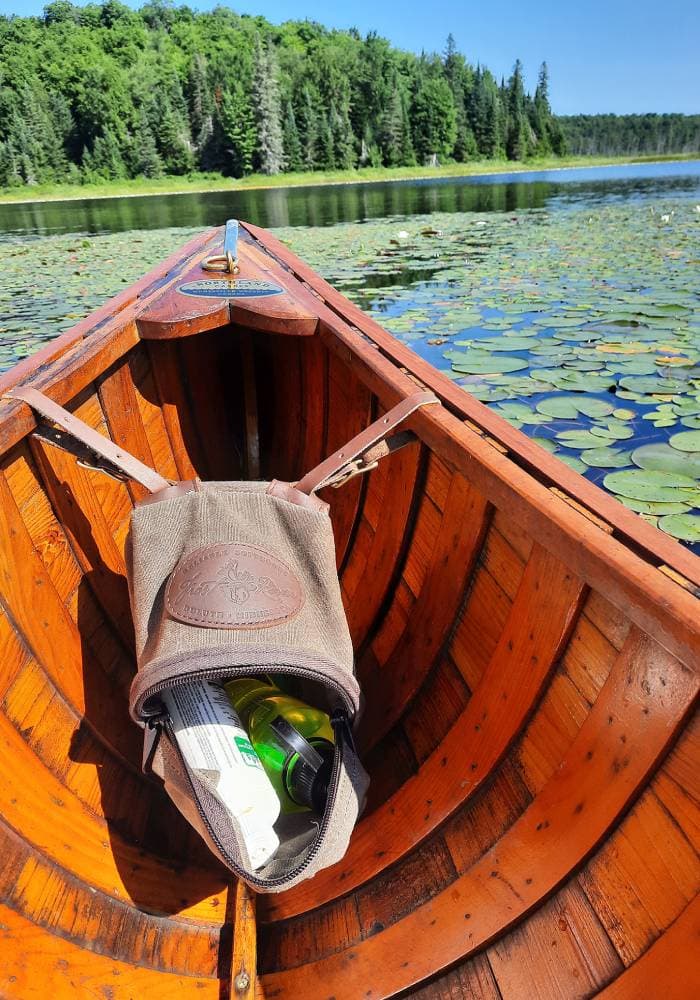
A great piece of kit for items you need at the ready is the Frost River Bow Bag. Made in the USA; this traditional waxed canvas and leather canoe mountable bag is perfect for essential items that can permanently stay on the canoe during the season. I keep things like bug dope, a compass, a water bottle, sunscreen, my bug head net, and my waterproof phone case.
The Frost River Bow Bag is larger than you would think and due to the way it is shaped, it nests within the bow (or stern in my case) of your canoe for easy access. Just lean and grab. I try to keep non-food items in this bag so that I can keep it always filled and attached to my canoe. By not keeping food in the bag limits the interest of mice and other critters while you have your canoe stored (possibly outside). During the day of paddling, I might toss a sealed granola bar in there for a quick snack that I can just lean back and grab. If you just keep to the essentials, it doesn't not throw off the balance of the canoe by much, or you could get another for your partner in the other end of the canoe and balance it out more!
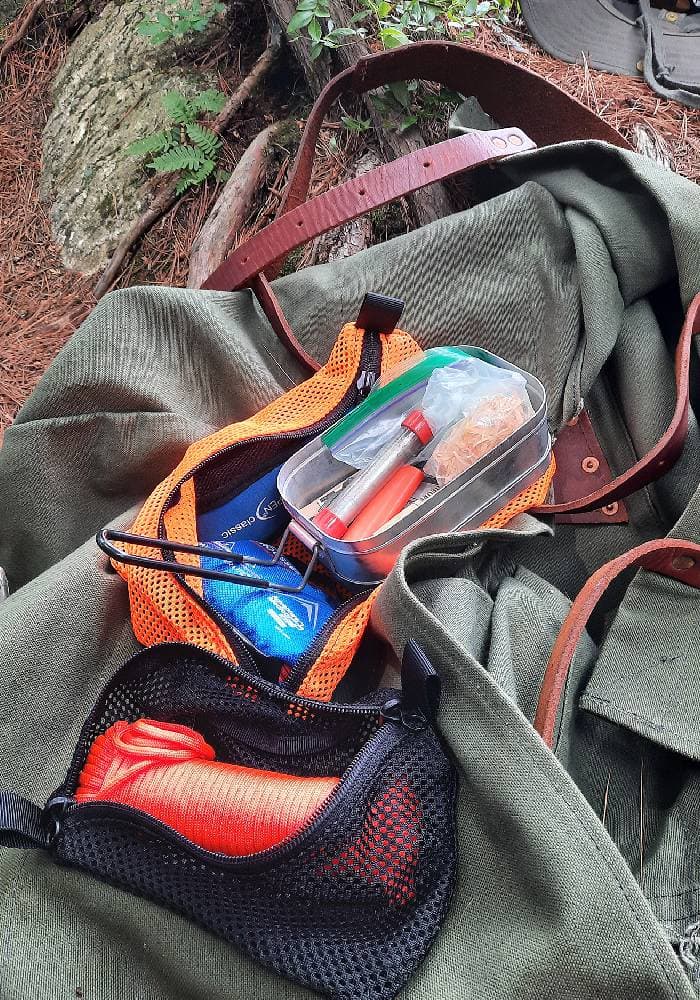
Another item I have found to be helpful in being able to spend more time outside, rather than looking for my gear is the Savotta Trinket Pockets. These gear sacks are made in Finland & Estonia and are made of a mesh construction so that you can easily see what is inside if you have multiple of the same size. The Trinket Pockets also have a full diagonal zipper which allows for larger items to be kept inside.
I have a few of the orange and black pockets as I like items that are bright in my backpack, or on the ground. It leaves less chance to leave it behind. The Savotta Trinket Pockets have become one of my favourite items recently. I always have 3 pockets on-the-go. One larger pocket stores my water purification set up, a small Trangia Mess Tin filled with fire starting tools, and a mini first aid kit. I keep another Small Trinket Pocket filled with my lighting gear like our Fenix CL09 camp Lantern, my headlamps, and a mini Isobutane lantern. Lastly, I keep a Small Black Trinket Pocket filled with cordage. The Pocket will hold about 150 feet of Paracord bundled into 50 Foot rolls. The fact that you can keep these items in the pockets for easy transfer from day trip to a week-long canoe trip is great. I don't even need to go through them as their contents never change. I am partial to the orange, as it is fluorescent, and easy to see in the darkest of bags or amongst the forest detritus. One would have a hard time losing it. These pockets are extremely well made and are clearly meant to last a lifetime. Savotta backs them with 5-year warranty. Good on them!
With these few items and a small day pack one can explore the Crown Land they have nearby. It does NOT NEED to be in a canoe. Go hiking or bring your ATV. Most of these activities are allowed on certain Crown Land as per their website. The idea of keeping gear at the ready is worthwhile. It can help hone your gear to what you use and perhaps lightens your load by getting rid of the gear which never sees the light of day. So, get outside, find those unexplored back country lakes, and turn what could be a boring weekend at home to a day out in the bush finding gems off the beaten path. There is so much to see, so many beautiful lakes to paddle and trails to find!
Remember to be safe, let someone know where you are going and when you will return, and most of all have fun!
Chris Adamiak

Chris' passion for the outdoors comes from his scout leader father. Having been on dozens of canoe trips from age 7, his love for the woods is deep. As a young adult time was split between paddling Ontario’s parks and rivers like the Missinaibi up to James Bay, and writing a blog about traditional outdoor gear and adventures. Wanting to be closer to Algonquin park, Chris and his family took the leap and built a log home on 50 acres in Huntsville, Ontario. His time is now spent homeschooling, exploring in and around the park, woodworking, and collecting anything by Bill Mason.
